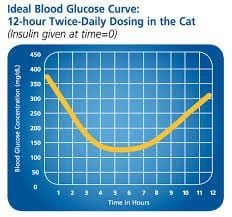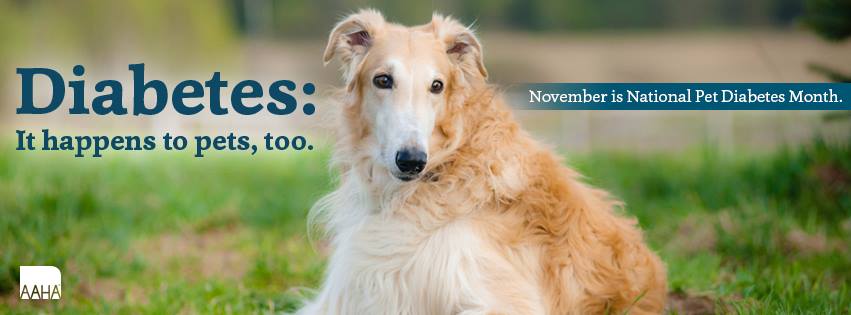It’s pet diabetes awareness month, so here are the top 10 things we think you need to know to protect and monitor your pets from this debilitating disease.
- Here comes the science part: There are 2 types of diabetes in out pets: Diabetes Insipidus (DI) and Diabetes Mellitus (DM). Diabetes insidious is a rare disorder commonly called ‘water diabetes’. It is usually either congenital (born with it), associated with trauma or a secondary condition like cancer, trauma or infection e.g. pyometra (pus in the womb). As it is rare we are not going to concentrate on DI in this post however much of the symptoms are the same as DM.
- Diabetes Mellitus (DM) is a disorder of the endocrine (hormone) part of the pancreas where there is a lack of insulin due to inadequate secretion of a type of cell in the pancreas called the beta cells. What this means is that carbohydrates and sugars cannot be a metabolised properly due to the insufficient levels of insulin. Insulin is a substance which our pancreas produces to control our blood sugars.
 There are two types of Diabetes Mellitus in dogs and cats: Type 1 – insulin dependent and Type 2 – non-insulin dependent. The most common type diagnosed is type 1.
There are two types of Diabetes Mellitus in dogs and cats: Type 1 – insulin dependent and Type 2 – non-insulin dependent. The most common type diagnosed is type 1. - Animals are often older when developing the disease, most commonly from middle-aged (5/6years old) to older dogs (geriatric, >7years old) with an average age of around 7-9 years old. However, cases have been diagnosed as young as 4 years of age or as late as 14 so it is very important that you know how to recognise the symptoms throughout your pets life.
- So who is at higher risk? Female dogs are twice as likely to develop the disorder than male dogs. Certain breeds have a genetic predisposition to the disorder. (Miniature Poodles, Dachshunds, Schnauzers, Cairn Terriers and Beagles are some of the breeds particularly prone to Diabetes Mellitus). However it is possible for it to develop in any breed. While there is no breed predisposition in cats, males are commonly more affected than female cats most commonly from the age of 6 upwards and is more common in castrated cats. Adding further to the simple fact that cats are NOT small dogs!


5. The Symptoms, what to look out for in your dog/cat:
- excessive drinking – ‘polydipsia’, are you filling that water bowl way more frequently that you used too??
- excessive urinating: this can manifest in ‘accidents’ where they normally wouldn’t have any ‘polyuria’, or they may just be looking to go outside a lot more frequently.
- Excessive eating – ‘polyphagia’, they seem to be hungry all the time?
- Weight loss: (combined with any of the above) in spite of what people think about diabetes, these animal tend to be thin! Eating well and losing weight is one of the most common signs they present with. Pre-diabetic pets are often over weight before developing the disease and then go on to lose weight and become under weight.
- Cloudy eyes, white appearance in the centre: Bilateral cataracts are commonly seen in diabetic patients.
- Chronic or recurrent infections are also quite common due to reduced resistance to infections. Urinary tract infections are a very common presentation as glucose spills out of the kidneys and into our pets bladders and creates a lovely warm medium for bacteria to thrive in. Requiring chest infections are also common indicators of presence of the disease.
- Ketoacidosis: this a life threatening complication of diabetes, your pet will be off their food, not eating or drinking and breaking down their muscle mass in an attempt to sustain themselves. This stage is a true emergency and needs immediate veterinary attention.

 6. If you’re concerned that your pet may have diabetes or is exhibiting any of the above signs; it is advised that you contact your vet for routine tests. For Diabetes Awareness month we are Rockhall Veterinary are offering FREE Urine/blood test. So come down to Clare Street Vets, Limerick & Shannon Vets, Shannon Co. Clare, for your FREE test.
6. If you’re concerned that your pet may have diabetes or is exhibiting any of the above signs; it is advised that you contact your vet for routine tests. For Diabetes Awareness month we are Rockhall Veterinary are offering FREE Urine/blood test. So come down to Clare Street Vets, Limerick & Shannon Vets, Shannon Co. Clare, for your FREE test.
7. Whats involved with Diagnosing Diabetes: tests may involve collecting a simple urine sample from your pet and testing it for glycosuria (sugar in the urine), and/or a quick blood test to assess the animal’s glucose levels in the blood. The blood test involves pricking the inside of your pets ear for example and taking a drop of blood and testing it on a glucometer. It is minimally invasive.
If these tests are positive, then your pet may be admitted for a test called a blood ‘glucose curve’. And other tests to look at their other organs and if there is any damage to them.
8. What is a glucose curve? We take your pet into the hospital for the day, fasting (no breakfast), we take a blood sample before we feed them and again after we feed them, then we administer an appropriate dose of insulin and observe your pet and repeat the pin prick blood test every 1-2 hours throughout the day, and monitor your pets response to insulin, a second insulin injection maybe required. This allows us to control your pets diabetes appropriately. Any underlying infections can be treated at the same time.

9. Finally, DON’T PANIC, if you have a Diabetic pet, we train our clients whose pets have diabetes on how to draw up their insulin, store it and administer it to their pets. We support you through learning how to manage your pets condition with dietary advice, management and training in what to do if their blood sugar goes too low using glucogels and other medications and importantly, what to do in an ketoacidotic emergency. We will take you through this process step by step. Early intervention is advisable before the damage is irreversible. We at Rockhall Veterinary, Clare Street Vets and Shannon Vets are here to support you and your pet. We always have an emergency Vet on call 24hours a day/7 days a week. Call our clinic number for directions Clare Street Vets Emergency Vets 061415104, Shannon Vets Emergency Vet 061472161.
10. Remember the foundation of successful longterm management of the disorder is mainly dependent on communication between theVet and the owner and compliance in administering the therapeutic medications. A multi modal approach to to prevention and management is vital and treatment of Diabetes Mellitus involves insulin therapy, weight reduction if necessary (not always), diet management and your pet can go on to live out a happy and healthy life with managed diabetes.


 There are two types of Diabetes Mellitus in dogs and cats: Type 1 – insulin dependent and Type 2 – non-insulin dependent. The most common type diagnosed is type 1.
There are two types of Diabetes Mellitus in dogs and cats: Type 1 – insulin dependent and Type 2 – non-insulin dependent. The most common type diagnosed is type 1.


 6. If you’re concerned that your pet may have diabetes or is exhibiting any of the above signs; it is advised that you contact your vet for routine tests. For Diabetes Awareness month we are Rockhall Veterinary are offering FREE Urine/blood test. So come down to Clare Street Vets, Limerick & Shannon Vets, Shannon Co. Clare, for your FREE test.
6. If you’re concerned that your pet may have diabetes or is exhibiting any of the above signs; it is advised that you contact your vet for routine tests. For Diabetes Awareness month we are Rockhall Veterinary are offering FREE Urine/blood test. So come down to Clare Street Vets, Limerick & Shannon Vets, Shannon Co. Clare, for your FREE test.